- Fluid-Structure Interaction: Vortex-Induced Vibrations, critical flutter speed, robust aeroelastic optimization
- Stochastic aeroelasticity : Uncertainty Quantification, Bayesian Inference, Data Assimilation
- CFD : Compressible flows, high-order Finite volume and DG methods, ALE formulation, dynamic grids
Current projects
- FlexHALE (ANR-24-CE51-7440) : Prediction and Prevention of Aeroelastic Risks in Highly Flexible HALE Pseudo-Satellites
High-Altitude Long-Endurance (HALE) pseudo-satellites are solar-powered drones. Their virtually unlimited endurance makes them an environmentally friendly alternative to satellites. However, most past and current solar HALE drone projects have encountered major aero-structural issues. These aircraft, both very lightweight and with large wingspans, have extremely flexible wings, making them particularly vulnerable to gusts and aeroelastic flutter phenomena. The FlexHALE project aims to model and optimize these composite structures by combining theoretical models, experimental data, and artificial intelligence, in order to improve their strength and reliability in flight.
Partners : CREA École de l'air et de l'espace - ∂'Alembert Institute - ESTACA'lab- INRIA - ISAE-Supméca
- Numerical simulation for Fluid-Structure Interactions
Fluid-structure interaction (FSI) plays an important role in Mechanical Engineering when the mutual dependence of a solid immerged in a flow become significant. The natural coupling between the deformation of the structure due to the aerodynamic loads and the flow modification due to the structure movement may lead to undesirable and dramatic phenomena like fluttering of aircraft structures and vortex-induced vibrations in heat generator tube arrays. Solving multiphysics problems in the context of large scale industrial applications remains a challenge requiring both the use of advanced computational methods with high-fidelity turbulence modeling, moving grid capabilities and high performance computing (HPC) resources [11].
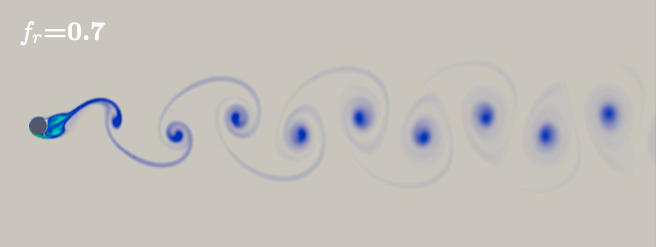
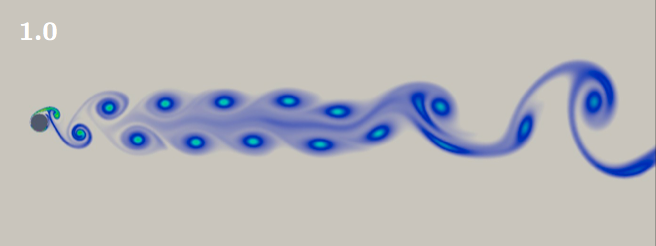
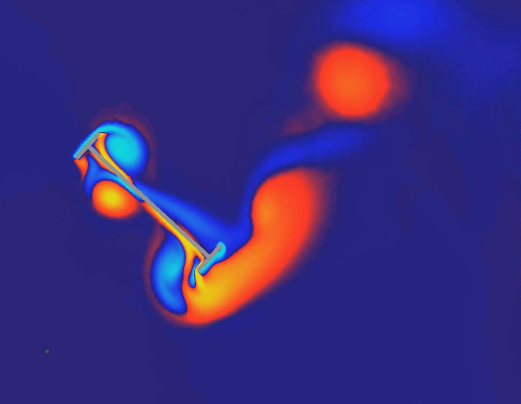
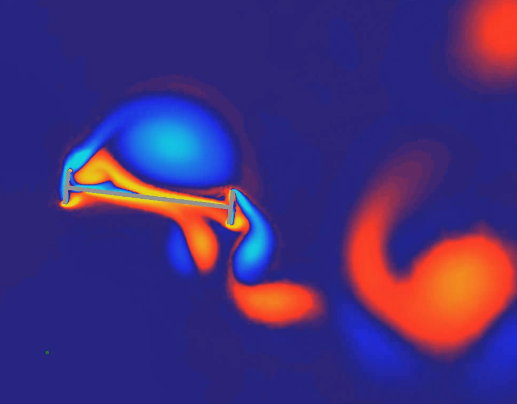
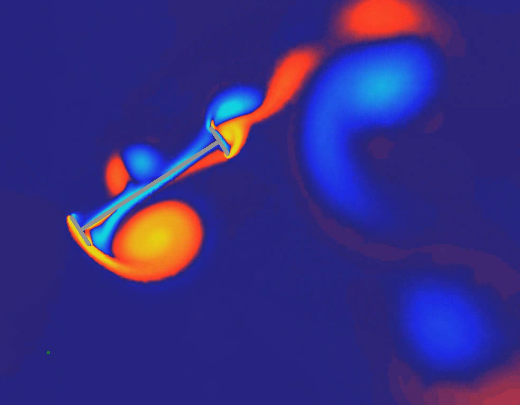
Computations of forced and self sustained oscillations using the CAEL aeroelastic solver on dynamic grids (Up: Cylinder wake forcing in the presence of a rotating cylinder at Re=200 for reduced frequencies equal to 0.7 and 1; Middle: Flutter mode of a 3DOF freely vibrating bridge deck at Re=150 , Down : Vortex shedding past a fixed squared at Re=213)
-
Uncertainty Quantification and Bayesian Inference in Aeroelasticity
The prediction of the flutter onset speed is of great importance in the field of aeroelasticity. The corresponding loss of dynamic stability, which results in unbounded vibrations of the structure, may lead to the failure of aircraft components. When nonlinearities are present into the structural or aerodynamic operators, the growth in the amplitude of the response is stabilized to limit cycle oscillations (LCO). These oscillations can be seen as the consequence of the bifurcation from a stable solution to an oscillatory behavior of the nonlinear dynamic system. Depending on the nature of the nonlinear restoring forces,one can expect to get both supercritical (small amplitude) or subcritical (large amplitude) LCO when transitioning through the Hopf bifurcation point. Because LCO are inherently sensitive to small variations of the aero-mechanical parameters, stochastic methodologies devoted to the quantification of uncertainties are well suited to obtain more insights in the physical flutter and LCO mechanisms with aff ordable computational requirements.
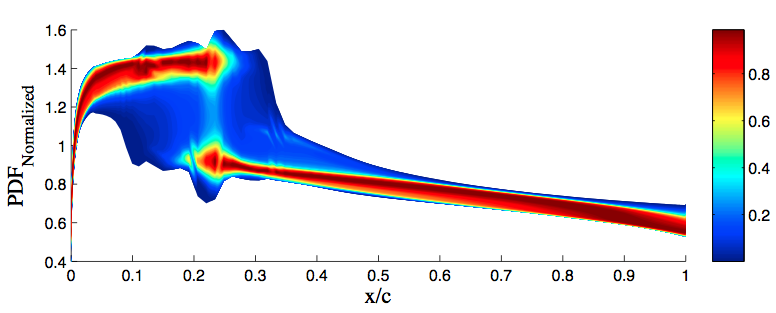
Uncertainty quantification in CFD an Aeroelasticity using stochastic spectral projection methods
( Probability Density Function of the isentropic Mach number on a NACA0012 airfoil surface due to random variations in the inflow Mach number and angle of attack computed using gPC with P=6 [7]) -
High-order Compressible numerical methods
Achieving high-order of accuracy on unstructured grids remains a great challenge to effectively capture complex flow features in computational fluid dynamics and computational aeroacoustics. During the last decade, high order continuous finite element methods(FEMs), discontinuous Galerkin methods (DGMs) and spectral volume methods (SVMs) have gained popularity for the numerical simulation of compressible Euler and Navier–Stokes equations. On the contrary, the field of research for higher-order unstructured finite-volume schemes is less active, although second-order finite-volume schemes are routinely used for engineering problems. The key issue in the development of high-order unstructured finite-volume schemes is the implementation of efficient reconstruction procedures of unknown variables at the interface of the control volumes.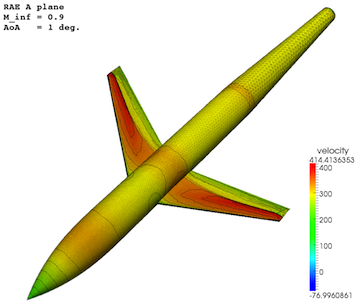
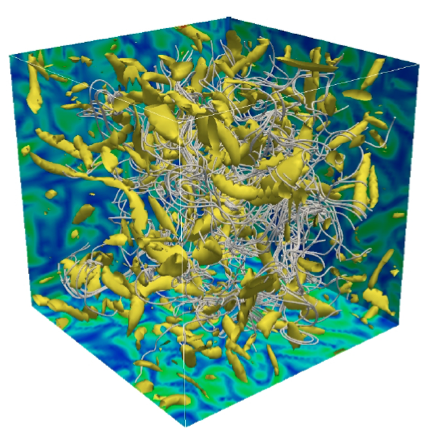 Moving Kriging reconstruction for high-order finite volume computation of compressible flows on unstructured grids ( Left: Transonic flow past the RAE-A plane at Mach Number equal to 0.9; Right: Decay of compressible isotropic turbulence at Re_t= 2157 [9])Acceleration of CFD solvers with a Graphics Processor Unit (GPU)
Moving Kriging reconstruction for high-order finite volume computation of compressible flows on unstructured grids ( Left: Transonic flow past the RAE-A plane at Mach Number equal to 0.9; Right: Decay of compressible isotropic turbulence at Re_t= 2157 [9])Acceleration of CFD solvers with a Graphics Processor Unit (GPU)Investigations of practical applications in Computational Fluid Dynamics often involve the analysis of complex wave patterns resulting from the combination of planar shocks, contact discontinuities and rarefaction waves. Such compressible flow feature are characterized by very small scales, requiring the use of advanced high-order numerical schemes with high spatial resolution. In order to deal with highly refi ned grids at moderated computational resources, GPU hardware can be employed to investigate the potential bene fit of developping multi-dimensional approaches for both flux-splitting and slope limiting.
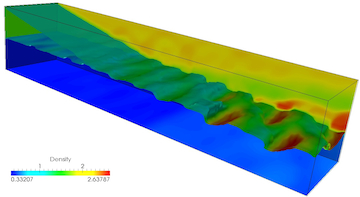
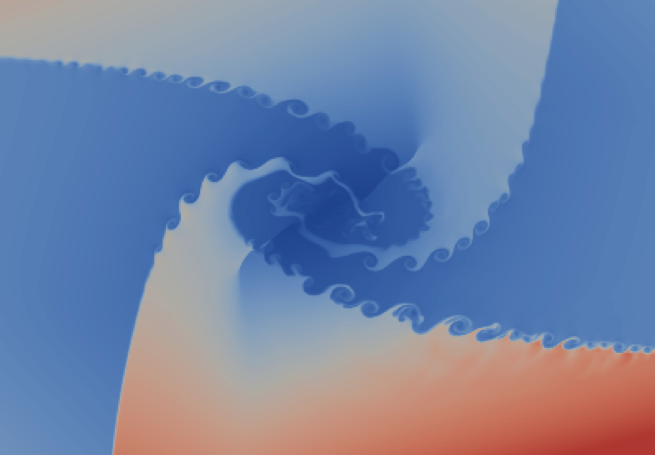 Multi-GPU CUDA implementation of a high resolution Navier-stokes solver for the computation of compressible flows on unstructured grids ( Left: Oblique shock/mixing layer interaction on a 2 Mpts grid; Right: Four states Riemann problem on a 2048x2048 grid - 7th order scheme - TESLA C2050)
Multi-GPU CUDA implementation of a high resolution Navier-stokes solver for the computation of compressible flows on unstructured grids ( Left: Oblique shock/mixing layer interaction on a 2 Mpts grid; Right: Four states Riemann problem on a 2048x2048 grid - 7th order scheme - TESLA C2050)
PAST STUDIES
-
Forced motion for transonic nozzle flows
It is we
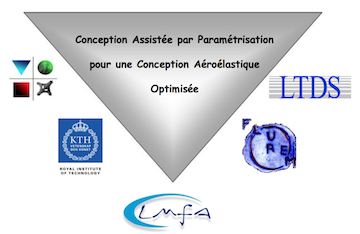 ll known that the computation of the unsteady aerodynamics forces by means of conventional time-domain RANS approaches results in unaffordable computational times for realistic flutter margin studies. The capCAO Project was devoted to the development of computationally efficient numerical methods formulated in the frequency-domain, namely the Linearized RANS (LRANS) and the Harmonic Balance RANS (HB-RANS) approaches.Various flow regimes, involving forced shock-wave oscillations due to an elliptical cam placed at the nozzle exit and forced vibrations of test objects, are investigated to assess the robustness and the computational efficiency of the two frequency-based approaches in the presence of recirculating flows (read more).
ll known that the computation of the unsteady aerodynamics forces by means of conventional time-domain RANS approaches results in unaffordable computational times for realistic flutter margin studies. The capCAO Project was devoted to the development of computationally efficient numerical methods formulated in the frequency-domain, namely the Linearized RANS (LRANS) and the Harmonic Balance RANS (HB-RANS) approaches.Various flow regimes, involving forced shock-wave oscillations due to an elliptical cam placed at the nozzle exit and forced vibrations of test objects, are investigated to assess the robustness and the computational efficiency of the two frequency-based approaches in the presence of recirculating flows (read more).capCAO: ANR funded project (2009-2012) dedicated to the development of frequency-domain based RANS solvers for the prediction of supersonic stall flutter of turbomachines (ECL-LMFA/LTDA,FLUOREM,UPMC-DALEMBERT,KTH)
- Combined time and frequency domain approach for acoustic resonance prediction (read more)
- Non-reflecting boundary conditions for the propagation of 2D monochromatic pressure waves (read more)
- 11th Standard configuration for unsteady flows throught axial-flows turbomachine cascades
- Flutter prediction of wide chord fan and centrifugal impellers

